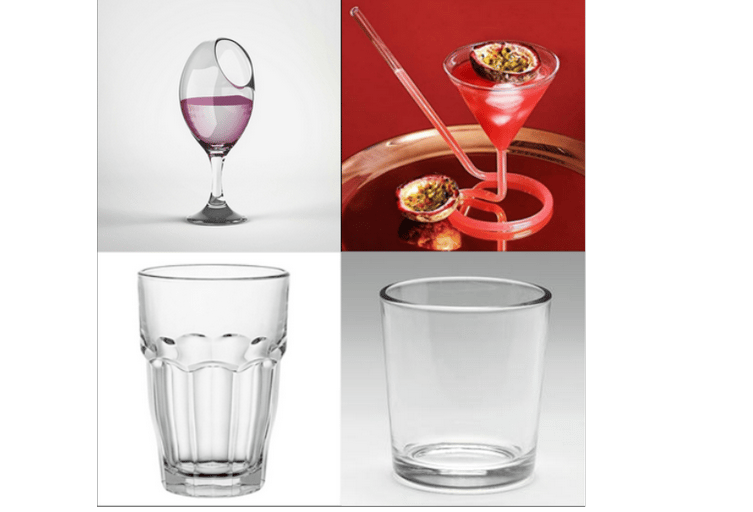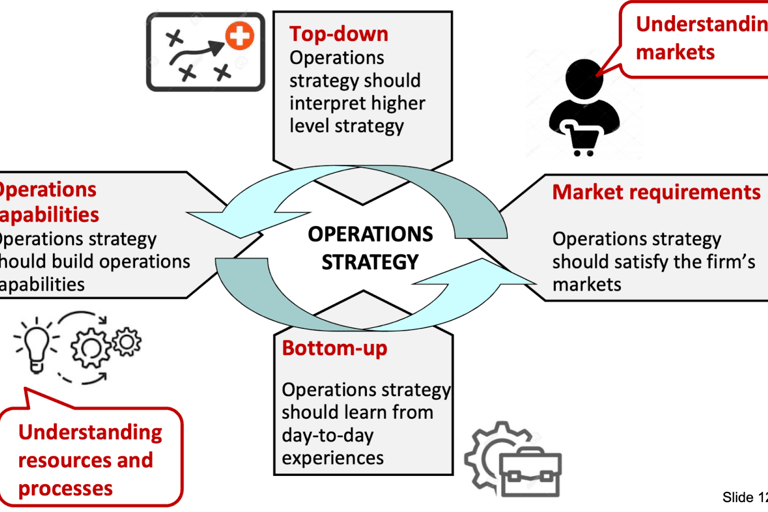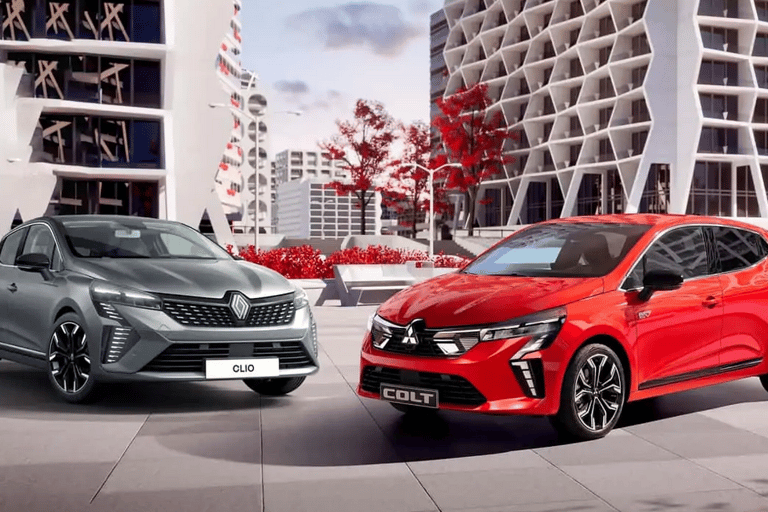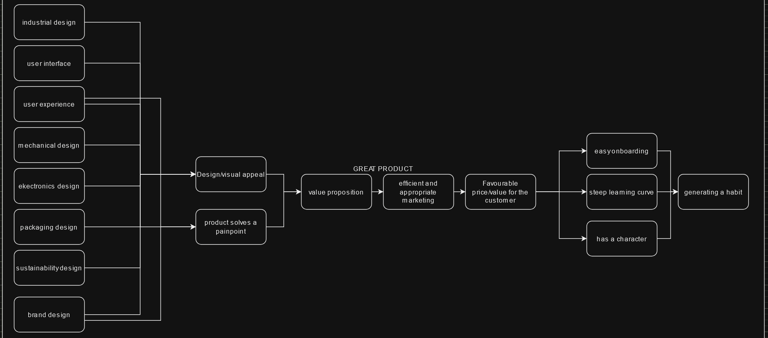What makes a product great?
"What Makes a Product Great?" explores the key elements that transform an idea into a successful product. From effective marketing strategies and thoughtful design to pricing strategies and intuitive user onboarding, this article breaks down the essential components that contribute to long-term success. Using real-world examples like Juicero and Apple, it highlights the importance of value propositions, emotional storytelling, and balancing functionality with aesthetics. Whether you're an entrepreneur or a product enthusiast, this deep dive will provide insights into creating products that truly resonate with users.
CAR DEVELOPMENT
Matej Kortnik
2/20/202515 min read


In the dynamic landscape of product development, the journey from concept to market success is a complex interplay of marketing finesse, design ingenuity, and a keen understanding of user needs. Crafting a product that not only meets but exceeds expectations demands a meticulous approach across various dimensions. This article delves into the critical elements that contribute to the creation of a standout product, exploring the realms of efficient marketing strategies, thoughtful design considerations, pricing strategies, and user onboarding experiences. Through real-world examples and practical insights, we navigate the intricate terrain of product development, aiming to unravel the secrets that transform a mere product into a solution that resonates with users, builds lasting habits, and ultimately stands the test of time. Join us on this exploration of what truly makes a product great, from its inception to its integration into the daily lives of consumers.
Efficient and appropriate marketing
You can have the best idea, most beautiful product or the strongest engine, but in order to make it functional you need a transmission to move it out of your garage.
This is where we need to signal a clear value proposition. A value proposition is the value that a company promises to offer to customers if they choose their product. [1] Even if a product addresses a user’s need, that doesn’t mean that users are aware of that need. To better explain this statement I will use the famous Henry Ford’s quote: “If I had asked people what they wanted, they would’ve said faster horses”. The real need that users had was to move from A to B, but because they were so used to the solution within the framework of what they were exposed to (horses) they weren’t able to think outside it. Perhaps the problem solved is something people are so accustomed to that they’ve never identified it as a problem in the first place. Maybe the product solves other, apparently unrelated problems, at the same time and that makes it harder to conceptualize. Your product’s proposition therefore has to be easy to explain, even to your grandma! Products with value propositions that can be explained in just a couple of sentences can reach wider markets more easily. Products that require you to do an MBA to understand their benefits might solve very real problems, but will find their target user demographics limited and will have to invest a lot into educating the market. [3]
We need to be convincing enough to encourage them to make a purchase.
To be more efficient before even starting the development of the product, we should already determine the “buyer persona” or in simpler terms, an ideal person who we want to sell our product to. We try to understand their needs, wishes, willingness to spend and interests. In that way we will be far better off with our expectations. We will create focus, build confidence, improve customer understanding and satisfaction, create clear and relevant messages and increase the effectiveness of marketing (and therefore use our funds more efficiently with marketing). [1]
Guidelines to create a clear value proposition:
Target your user’s main issue! (don’t sell the drill, sell the hole)
Identify everything your product can possibly offer to solve user’s main issue
Talk about in what ways your product is valuable
Create a connection between this value and your buyer’s problem
An effective product marketing is achieved through building an emotional connection with a customer. One way to do so is storytelling. Stories are moving, powerful, inspiring and memorable. With a combination of honesty, sincerity and uniqueness we are able to grab customer’s attention which enables us to sell them the product in a way that speaks from the heart.
It is however of crucial importance to act sustainably by staying true to our customers to ensure our long term success. Remember, a damaged reputation is hard to repair.
To support my statement and better explain the power of marketing i have found an example:
Juicero’s marketing was successful in creating a buzz and generating initial interest in the product, The company invested heavily in creating an image of exclusivity, health consciousness, and cutting-edge technology. The company had initially marketed the machine as an essential part of the juicing process, emphasizing the need for the machine’s technology to extract juice properly. The sleek design, the emphasis on high-quality ingredients, and the idea of a connected kitchen appliance all contributed to the perception that Juicero was a premium product worth its high price.
The product, however, faced significant backlash when it was revealed that the proprietary juice packs designed for use with the machine could be squeezed by hand, rendering the expensive juicer largely unnecessary. it was ultimately criticized for misleading consumers about the necessity and functionality of the juicer.
the marketing can be seen as deceptive, as it did not provide a transparent and accurate representation of the product’s value. The controversy surrounding Juicero serves as a cautionary tale about the importance of aligning marketing messages with the actual functionality and benefits of a product. Successful marketing should build trust and deliver on the promises made to consumers, avoiding situations where the product fails to meet expectations.
Stay true ladies and gentlemen, it’s a long way but a stable one (compared to the short one)
Design
It is important to understand that this big concept consists of many parts. We know industrial design, user interface (UI) design, user experience (UX) design, mechanical design, electronics design, packaging design, sustainability design and brand design. Of Course not all are applicable at the same time (we don’t need electronics and mechanical design in a software product, though some knowledge from there could still help us find a great and unique solution). Those parts are interconnected and a holistic approach involves a collaboration across disciplines. A successful product design integrates these aspects seamlessly to create a cohesive user experience while ofcourse meeting functional and business goals we also promised at the marketing stage and value proposition.
After we understand this we can proceed by explaining that there is no one solution. Yes there are some well established practices of the way the product is designed, but in order to develop something new, we have to actually try something new right?.
Still we shouldn’t just become allergic to established practices, though we should master them and then grow out of them. As mentioned already, we should know and understand our customer’s wishes and pain points or see a problem they might have that they don’t see (Ford example). The buyer persona plays a crucial role. We have people who are almost allergic to extra effort being put into the design of the product and simply want the product to be simple to use and solve their issue. Nothing more and nothing less. Those customers are usually running a business and this one product probably solves just a small portion of their problem, hence their view of extra design is unnecessary bling (unless they want to boast or reward their employees). Perhaps we could also say that because so many products solve the same problem in the same way, the only distinction actually becomes the visual design.
A casual customer however, will usually appreciate visual design much more (though again, it depends on the customer). People judge a book by its cover. There is so much information in the wild that we need to pick quickly. Applying the supply and demand principle we quickly decide whether a product/service is good or bad just by quickly analyzing it. First mistake we notice, the probability is that we will just let go of it and go for the next product. [1]
It is important to put some effort into making your product visually attractive, hence attracting people to try to learn more about it, adopt it and in the end perhaps buy another one. If done correctly, customers will also love to boast to their friends and proudly show it at their next dinner party, making exposure for the product and with it a promotion to other new “potential buyers”. A good product has an attractive appearance, and people tend to judge things based on their looks, even though they’re told not to.This happens in various aspects of life, like job interviews, first dates, and choosing products. The first impression is crucial, and once it’s negative, it’s hard to change. This is true for daily experiences, including products.
Popular brands often succeed partly because of their appearance. For instance, Apple products are admired for their minimalist design, making them visually appealing. While a product’s functionality matters, its appearance plays a significant role in attracting and keeping users. Consider a car you’ve never seen before. You may not know anything about its features, but you still form an opinion based on its looks. This tendency to prioritize appearance is normal and affects purchasing decisions. If users don’t like how a product looks, they might lose interest quickly. Therefore, it’s important to make products visually engaging to create a lasting and positive impression. This approach helps a product stand out, be memorable, and stay in the minds of consumers.
When we talk about visual design it can be of crucial importance or at least to some degree to make a sale, however it usually doesn’t overshadow the actual problem solving part of the product (might work on the short run as we discussed in the marketing stage).
To make it easier to understand i made this example of the same product with different focuses:


The first glass being on top left is beautifully crafted and definitely had the design as a priority. Though i think it should be pretty difficult to drink from this glass as your nose would be in a way, being hard to connect your lips around the hole and you would probably just spill your drink over yourself.
Bottom right example is painfully simple, though it’s undoubtedly functional.
The remaining two glasses share a balance between the function and the design. This is the wide range in which we want to be as a product designer. In order to stand out of the crowd however it is important to look out of the box.
In the end you should understand that you cannot satisfy everyone, you need to make some trade-offs (picking and sticking with one or few buyer personas). If your product is for designers, make it for designers, not photographers, writers, and managers.
Favourable price/value for the customer
This is a very important aspect to do correctly for your product performance as the price for value indicates the point of realization of a customer whether the product is worth their money, time or energy. (1) People are willing to spend proportionally to the value they expect to get out of the product. If the product is out of proportion in the customer’s benefit, awesome, it’s the spot you want to be in. However when the opposite occurs, customers will be unhappy about it and your sales will plummet, together with bad feedback and even reputation will take its toll. Therefore its important to understand the market by knowing what competitors are capable of providing the customers. From this we can grasp the market demand. In order to succeed in positioning yourself it is also important to match your capabilities with that market demand. The opposite also incurs. The market must be ready and opened for your product, otherwise you will crash and burn. Though a company that is persistent enough and able to convince the public can turn immensely successful and profitable (Apple’s iphone and Tesla with an electric car)Write your text here...


University of Ljubljana, school of economics
It is worth mentioning that outsourcing or cooperating with other companies may enable you to drive your costs down. If you are aiming to make a low cost car as your budget is lower it will be far cheaper to purchase an existing car kit, than developing your own chassis, engine etc… However, if you want to play the high quality and premium brand card, you should strive to do it by yourself. If you purchase a 100.000€ car and you find a cheap manufacturer’s components in it, I bet you would probably feel a bit cheated. Of Course this probably doesn’t affect the actual quality and safety of your car (i hope), nevertheless the feeling is probably not great as you could get the same part by purchasing a much cheaper car. The ugly truth is that manufacturers are trying to lower their production costs by sharing knowledge with each other. We consumers also benefit from this as the manufacturers are able to adapt to market trends much quicker and offer us a wider selection (as their costs are lower to do so) . The only difference now therefore is in the visual design ( interior and exterior, though if looked closely, you may notice some similarities between 2 “completely different cars”)Write your text here...


https://cars.usnews.com/cars-trucks/features/audi-rsq8-vs-lamborghini-urus
Audi rsQ8 and Lamborghini Urus are both based on Audi’s rsQ8, sharing the engine and chassis. There are only visual differences where the Lamborghini variant uses more premium materials, has more optimized power output and its design is matching its brand design which is the sharp and sporty style of the Lamborghini brand.
There are even worse examples, though the brand’s status do not differ so much among each other


https://biznis24.si/renault-clio-in-mitsubishi-colt-kateri-je-boljsi/
It is therefore of crucial importance either to make the product of better quality than the customer is expecting it to be, or to better hide/justify the flaws of the product. Second might give an illusion that is missing the whole point of this article, however if our product is very modern and uses the most recent ideas and methods (state of the art) then it is excused of poor detailing as the product will get better after some iterations.
Intuitive user onboarding/Steep learning curve (easy to start, easy to master)
A process of assisting new users to understand the workings of your product. A great user onboarding can help you with many things; it boosts activation, conversion, and retention while preventing churn at the same time. It is critical to improving the general success of your product. [1]
In short, people are having a hard time adapting to change and therefore are avoiding it like the fly avoids your hand. Simplifying/making the onboarding as intuitive as possible helps with convincing people to purchase and also makes it more likely that they will continue using your product. Remember, first impressions last.
People are lazy animals and even if we provide them with a perfect product that will perfectly solve their huge problem, they will need guidance as many of them tend to give up before reaching the goal (even if it would help them by a mile). Since you can’t really send an advisor to their home to explain all the wonderful functions so they can fully utilize the use of the product (exc. Expensive purchases like a vehicle/house etc…), the 2nd next best thing we can do is to make the onboarding process as intuitive as possible.
If we talk about a product, use as few buttons as possible, make a clear distinction among them. Carefully design the connectors and shape the product in the most ergonomically possible way (depending on how the product should be used) to make it “click” with the user. Additionally also carefully design the manual, using as little and simple text as possible.
Steep learning curve
For those not familiar with this principle, we are talking about the user needing to spend less thought in enjoying the value of the product each time the usage time doubles. (long story short we quickly learn and adapt the product into our lives making the integration unnoticeable).
People don’t like to study, nor accept the fact that they are a “newbie”. Taking a dedicated time to learn the subject means first accepting the fact that you do not know enough of the workings of the product to just go on living and using it.
It is important to understand that in some cases a flat learning curve also makes the product or service valuable as it displays a virtue of dedication, focus needed to master it to other people (status). This path wouldn´t be recommended to a new company still trying to set its foundations on the market, however for well established companies it may actually be a great option as the mastery difficulty becomes the value itself (mastering a Katana sword, professional camera, 3d printer etc…). Continuing from this there are of course many people on this planet with many preferences (some people don´t mind adapting and learning, while others do so very much) therefore you should carefully pick your buyer persona to properly design the product.
We can say that one of the biggest characteristics of today’s people is how fast they get distracted or bored. This is one of the major issues you need to be focusing on in order to create a good, long-lasting product. (1)
What can be done to increase the learning curve is the following:
Product tour at purchase
Interactive guides (for lone wolfs who don’t like to ask others for help)
Create as intuitive product as possible (goal is to make it´s name it´s instruction)
Tech support (if a product is more complicated a solid support will help convincing the customer to pick you over the competition)
Online forums (reddit is free)
A good product may be sophisticated yet it doesn´t need to be complex to learn and use (literally any car) “simplicity is key!”
Solves a pain point of a customer (makes user’s life better, delivers more value than expected) the product is responsive and delivers results in timely manner)
Now we are at the actual work. Here all your marketing comes to the test. You better did choose your buyer and appropriately matched the marketing with product performance, quality with the price as here is where the customer decides whether you are a W or a L. Remember, the real quality and the spot where you want to be is higher than where the customer expects the promised value (John bought a new smartphone and was thrilled not only from it´s performance but also that it now connects with the car and that he now doesn’t need to use his credit cards anymore though can do it all via his new smartphone. Another example would be that you just bought a new cool looking jacket and while being happy with its quality and all, you later learned that you are also able to remove the long sleeves and you even have a hidden compartment!)
This truly is the basis of any successful product: if it doesn’t solve a problem for an end user then everything else falls apart. No one would ever buy a tool to do something they don’t do. There are many different user needs: known and unknown, complex and simple, natural and artificially created, part of a chain of needs or standalone;
The takeaway is that a product needs to fulfill a need (and do it well) or it shall fail. User needs are not static, we wouldn’t have any new products otherwise. Likewise, new products might not cater for a new need, but simply channel an existing need in a different way: Facebook didn’t create the need for approval, belonging and friendship, but it found new ways of fulfilling it. Other products attempt to create new needs and offer themselves as a solution at the same time: While it is possible to pull this off, the value proposition will become dependent on that artificial need generation. Wedding rings are a good example of an artificial need that has managed to become so entrenched that most people take it for granted, but in reality, its only purpose is to fulfill the social expectation that jewelers have carefully crafted throughout the decades. [3]
To ensure the building of a problem-solving product, we must know our audience by observing and accepting feedback they provide us. Considering it we should act accordingly by targeting their problem when designing our product or making a new iteration of it.
Has a character/soul (user feels good when they are using the product)
A character is being defined by actions. A good product can do its task of solving the pain point consistently, however a great product makes you remember or/and enjoy it. It is not necessary that the whole process is enjoyable, it can still grow onto the consumer (though this usually only works for well established companies using their prestige (apple’s airpods, back in my days it was absolutely absurd to think of charging your headphones) or if it used to be no substitute (a car with a manual gear shifter, driving can be simply indication, gas, brake and steering action, making it pretty simple now, yet some people still love manual gear shifter and think that the automatic gearbox is a crime even though they have to work more when driving…)). Character of the product is the spot where your product has a chance of becoming an icon. Do it right and your product integrates itself into the consumer’s vocabulary (coca cola, google, aspirin…)
Generates a habit
This is a tricky one, however if we have done all of the steps right, users will grow on the product. The longer they use it, the more they get used to it and the problem we faced before now actually works in our favor. People are lazy animals and change is difficult for them.
Summary:
To truly make a great product, it’s absolutely crucial to be bold. Sadly with boldness sits the risk, risk to crash and burn. By using standardized practices we tend to stay on the safe and calm ride, however we will never do anything truly outstanding and unique. When i talk about uniqueness i’m talking about changing the marketing and the technical execution of the product as well as the spirit of the company which sells it. It’s important to test the cultural borders, to make new technical solutions that either no one has tried before or tried and failed. The truth is that people are attracted to risk, though observing it from a safe distance (cough Roman games). We can’t help ourselves but to see if the one who stands and goes for the ideal will fall or slay the dragon.
In essence, creating a successful product involves a holistic approach, incorporating marketing, design, pricing, user experience, and continuous adaptation to user needs.


a diagram to easier grasp the important aspects to design a great product!
References:
1. What Makes a Product Good? – 11 Qualities to Consider (userguiding.com)
2. https://productsthatcount.com/what-makes-a-great-product/
3. https://www.mindtheproduct.com/what-qualities-make-a-product-great/
